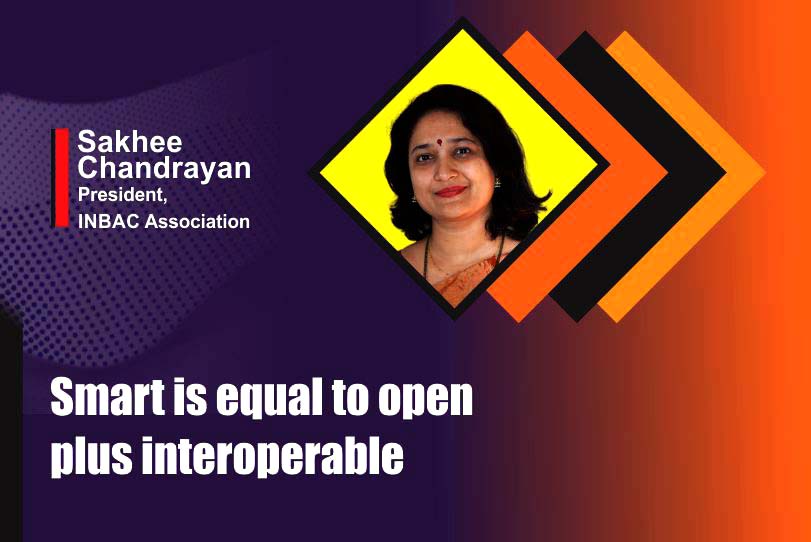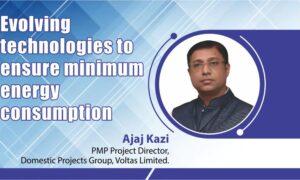It is very important to innovate, at the same time it is very important to use the optimum technology in the building.
Let us start imagining some industry or let us start imagining some airports for that matter. Ms. Sakhee Chandrayan, President, INBAC Association responds that we all engineers here work in HVACR, so I thought that it makes sense to put the topic in the equation. We will talk about why this equation makes sense.
Huge commercial building setup
Smart is equal to open plus interoperable, and let’s talk about smart infrastructure or Digital India. I recall a quote from one of my colleagues who is also chair of the standardisation committee in INBAC, which is an integrated building automation community that says ‘our buildings breathe’. So when our buildings breathe, it creates a lot of things right, all the nonliving things which breathe, they have the degenerative properties, the human pains and all the living things also to an extent have degenerative properties. So when we talk about degenerative properties, we also talk about pollution directly.
Indoor air quality
It was very surprising even for me to know that the pollution inside the buildings is two or three times higher than the pollution outside the buildings. So what are the things which create this pollution? There are things that we use inside the buildings: the chemicals that we use for cleaning the buildings, then the people who breathe inside the buildings and all the manufacturing work that happens, all the work that happens or the material that we have used, which means that the ventilation system is crucial.
In the new era, wherein we are working mostly from inside our houses, as well as inside the confined buildings and a little scared of the medical conditions outside, I think we are very careful about ventilation systems. When we talk about the ventilation systems, we talk about this Smart HVACR and here the right aspects of growth that we need to consider. The first one being the growth spread.
Growth spread vs smart cities
In the growth spread, we’ll talk about the parallel group. So let’s start from the smart cities. So when the Smart Cities grew, eventually the HVAC grew and eventually the control and management system had to grow. So there is a lot of parallel growth and there is an interdependent growth. This aspect is very important to understand. We are focused on HVAC, there is a lot of dependency on this topic on the other topics like lighting.
Lighting has illumination, it has radiation. HVAC also deals with thermal, which means that lighting to a large extent impacts how we can optimise the HVAC or the next aspect of growth. When we talk about growth essentials, we need to talk about the base of the growth in India.
Collaborating with other parties
And also the scale is not the time when we say that I will do a 100 crore worth project in two years. Now is the time when we talk about collaborations, how can I do it in one month? How can I do it in six months by collaborating with other parties by making the use of all the industry leaders, all the industry experts, innovators and researchers, and this brings in the pace and the scale of growth in India.
Open plus interoperable
When I talk about open plus interoperability, there are three focal points that I’m going to talk about. Before that, we should know what is smart. When we talk about this specifically, it is measurable, achievable, reliable, and timely. If we agree on these aspects, then only we can say that some systems that we are installing, using and developing are smart.
The first focal point that I’m going to talk about is the project impact. We also saw the project which is a personalised test management system right now. So let’s graduate to say huge buildings or infrastructures like airports. When it comes to the project impact, having an open and interoperable system can bring energy efficiency by optimising all the aspects which have to be integrated in the next aspect that you have to be careful about and introduce, which is crucial for cyber security.
We have the connected systems, open interoperable systems we know how cyber security attacks and have the mechanisms to prevent it with the right open and interoperable protocols or communication protocols in any system that we deploy. We have to talk about technology. So every day we have the pace and scale of the growth today because of technology.
The technology has no barriers of countries or continents, it is seen everywhere in the world. Now, this technology plays a vital role in the project and when we talk about technology, it is very important to innovate. At the same time it is very important to use the optimum technology in the building that is under construction, which is specific technology. The most important aspect that a building has to talk about is the HVAC system and its integration.
Integrating any system with the other system, which is crucial, any integration can help to control. Only integration can help you measure and it can help you actually talk about predictive data analytics. When we do the right integration, we can move on to the successful project implementation. So, what we commit we have it with a successful project implementation, we can actually expect the performance continuity, which includes return on investment, and these days the return on investment is not sufficient, but we also have to talk about NOI that is the net operating income, like the entire building is dependent on each other for functionality. We have to also understand that all these aspects which are mentioned are interdependent.
Let’s look at the net operating income. Suppose you have new innovation coming in and this innovation is based on the open and interoperable communication protocol only then you can integrate it faster in your buildings and increase your net operating income. This also helps us to basically take the advantage of the entire industry, I mean, we have safety solutions, but these solutions will not talk to each other. This could be not a very good team in any building that wants to go for more innovations. When we talk about performance, we continue to talk about the data, which we are not only consuming but collecting over a period of time. All the trend data helps us in not only predictive maintenance, but it also helps us create perceptions where the industry could be moving further, and it also helps us to teach new business opportunities. There are many more factors that we can talk about in the project.
Local market impact. And when it comes to open and interoperable standardisation, open communication, interoperable communication, we have learned that it actually increases the availability of products. How does it increase the ability to say I am an innovator or I have a startup? I have a very innovative solution for one of the aspects of a file, but I don’t have everything to offer to the client in the entire building. Now, if I am on the open and interoperable platform communication protocol, then I can integrate with multiple other functionalities which can serve as an entire purpose serving solution.
We are at such a point in India and are poised for enormous growth. This growth can be only achieved by encouraging support in the start-up and MSME infrastructure and letting people innovate. We have been followers, if I may say so, for a lot of time, we have been only customising the solutions which come from other countries especially from Europe or the US. Now, we have started making the products which are suitable for this country and this continent. And if we have to actually grow, and increase our GDP, then we have to strengthen the startup innovation infrastructure, and the way to do it is to engage in open and interoperable communication protocols.
Innovation standardisation
Innovation and standardisation go hand in hand. Innovation brings in new aspects of standardisation, letting it get integrated with the existing system. And this is the reason that the communication needs to be standardised, maybe the USP so you, every product company, every seller may have their unique selling points. However they need to have communication over a standardised open and interoperable background. A very crucial topic to deal with is, this country has skilled manpower. You need to definitely deal with the skilled manpower and with the pace and the scale of growth that is happening in the industry, we have to ensure that they are upskilling, not only skilling when it comes to open and interoperable protocols running multiple organisations. Multiple stakeholders in the entire market work together to achieve it.
The skilled manpower creating the skilled manpower is possible. It is not only possible, but it is actually very effective skilled manpower. Now, we are at the topic of local market impact, let’s talk also about the global impact with the open and interoperable, we bring the products to the entire globe. So, availability of products, when you create based on the open and interoperable global communication protocols, you are actually making your products available to the entire world.
Innovation and standardisation also to the entire world.
It is very important to understand the collaboration when it is open and interoperable. And we are talking about the global standards, we are not going to limit ourselves to any country, any piece that we are open to take advantage of the entire industry. Now, we are not only integrating project related impact for one building or one premise, we are integrating for intelligence.
We are bringing this intelligence, and we are providing the skill and unskilled manpower to the entire world. My organisation is an integrated building automation community. With all the colleagues, we work upon all this knowledge coming to you from INBAC as an association which is the collective knowledge from all the experts working together. So, this is the local context and global content where we have to understand that we have to have global relevance, which will only help us to make it in India. It has to be a two way journey really and adopt the standard.
At the same time we contribute to the standard. The do’s and don’ts, let’s have open, not proprietary that are connected and interoperable, not siloed and restricted communication. Let’s have global certifications not self declarations. Let’s have evolving protocols, not stagnant, triggered protocols. Let’s have coverage not limited. Let’s adopt and contribute to ISO based global standards and not reinvent India which is already there to keep the global relevance, concludes Ms. Sakhee.
Cookie Consent
We use cookies to personalize your experience. By continuing to visit this website you agree to our Terms & Conditions, Privacy Policy and Cookie Policy.















